The Intel SSD 660p SSD Review: QLC NAND Arrives For Consumer SSDs
by Billy Tallis on August 7, 2018 11:00 AM ESTAnandTech Storage Bench - Light
Our Light storage test has relatively more sequential accesses and lower queue depths than The Destroyer or the Heavy test, and it's by far the shortest test overall. It's based largely on applications that aren't highly dependent on storage performance, so this is a test more of application launch times and file load times. This test can be seen as the sum of all the little delays in daily usage, but with the idle times trimmed to 25ms it takes less than half an hour to run. Details of the Light test can be found here. As with the ATSB Heavy test, this test is run with the drive both freshly erased and empty, and after filling the drive with sequential writes.
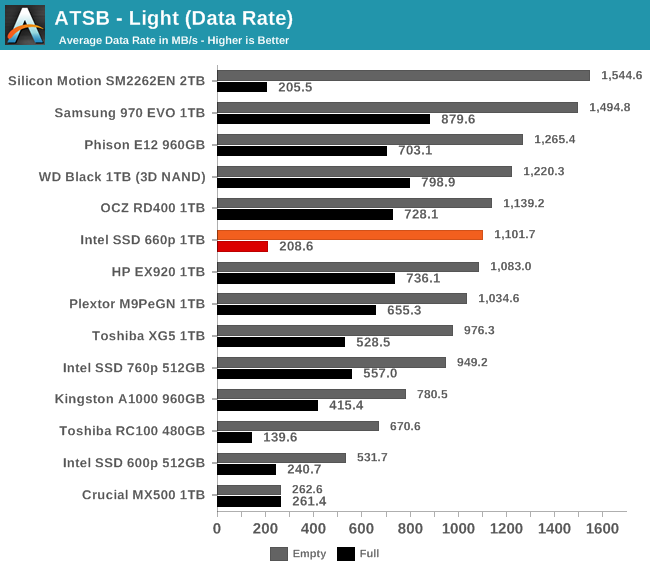
As with the Heavy test, the SLC cache of the Intel SSD 660p is extremely beneficial and brings the average data rate of the 660p up into high-end NVMe territory. When the drive is full and the SLC cache has been reduced to its minimum size, performance suffers and drops below the Crucial MX500 mainstream SATA drive but not all the way down to the level of the Toshiba RC100 DRAMless NVMe SSD.
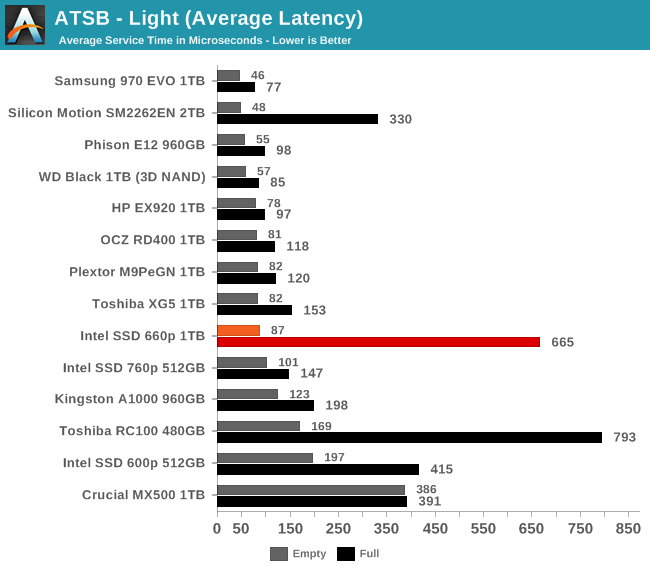
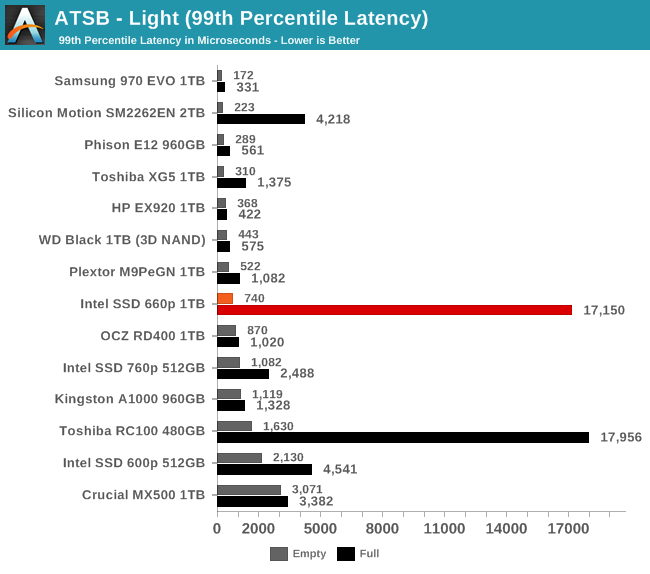
The best-case latency scores from a freshly-erased 660p are acceptable for a high-end NVMe SSD and excellent for an entry-level drive. In the worst case of a full drive, the average latency is far higher but still low enough that the drive won't actually feel much slower. The 99th percentile latency climbs very high by SSD standards, but is still barely up into the average latency range of hard drives.
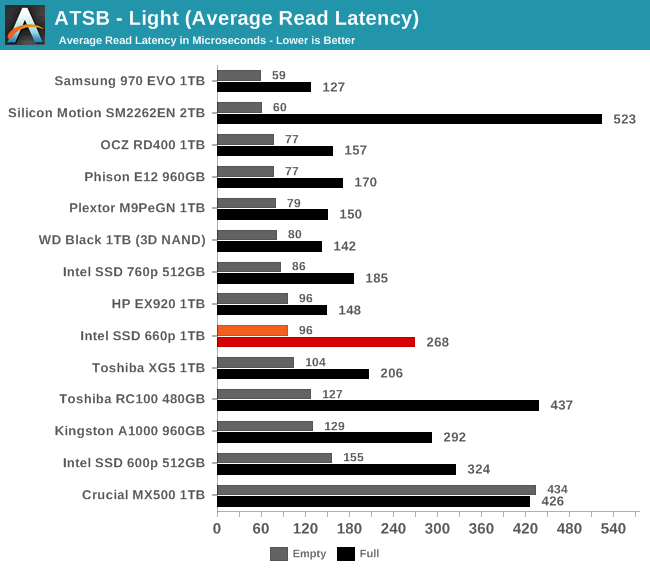
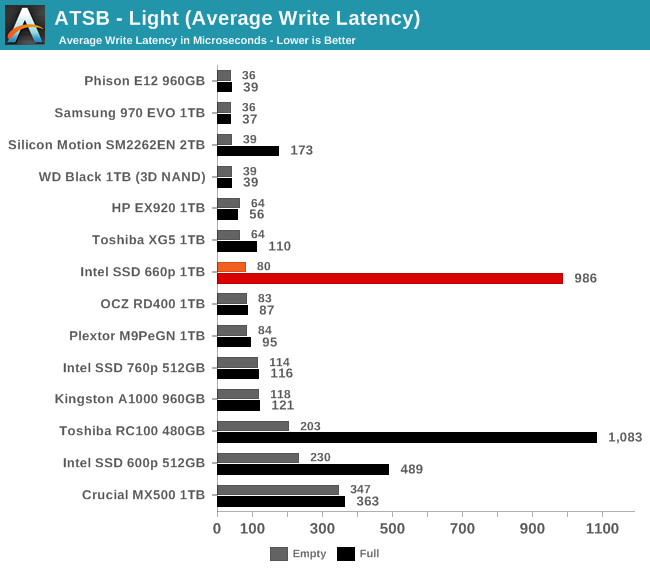
On the Light test, the average read latency of the 660p stays comfortably below that of SATA drives even for the worst-case full drive test run, and only the average write latency shows a serious problem from filling up the whole drive and not giving it enough time to empty the now-reduced SLC cache.
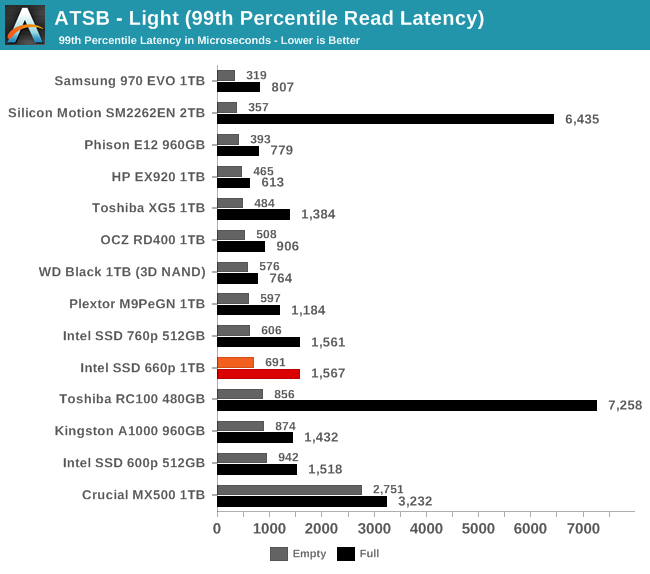

The full-drive 99th percentile write latency of the 660p on the Light test is almost as bad as the 600p or the Toshiba RC100. Otherwise, the 660p doesn't have any worrying QoS problems on this test and users won't notice serious pauses from the drive.
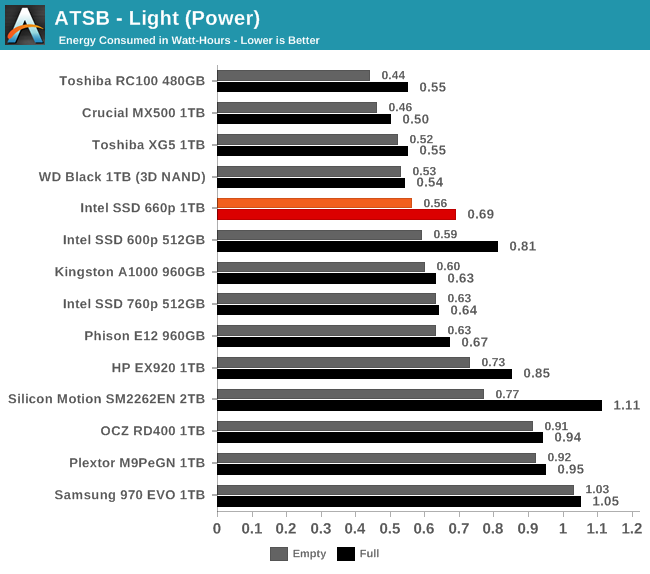
The energy usage of the 660p on the Light test is below most other NVMe drives when the test is run on an empty drive, and even with the extra background work and longer test duration of the full-drive test run the 660p is only a little less efficient than the average for this bunch of NVMe SSDs.










86 Comments
View All Comments
limitedaccess - Tuesday, August 7, 2018 - link
SSD reviewers need to look into testing data retention and related performance loss. Write endurance is misleading.Ryan Smith - Tuesday, August 7, 2018 - link
It's definitely a trust-but-verify situation, and is something we're going to be looking into for the 660p and other early QLC drives.Besides the fact that we only had limited hands-on time with this drive ahead of the embargo and FMS, it's going to take a long time to test the drive's longevity. Even with 24/7 writing, with a sustained 100MB/sec write rate you're looking at only around 8TB written/day. Which means you're looking at weeks or months to exhaust the smallest drive.
eastcoast_pete - Tuesday, August 7, 2018 - link
Hi Ryan and Billie,I second the questions by limitedaccess and npz, also on data retention in cold storage. Now, about Ryan's answer: I don't expect you guys to be able to torture every drive for months on end until it dies, but, is there any way to first test the drive, then run continuous writes/rewrites for seven days non-stop, and then re-do some core tests to see if there are any signs or even hints of deterioration? The issue I have with most tests is that they are all done on virgin drives with zero hours on them, which is a best-case scenario. Any decent drive should be good as new after only 7 days (168 hours) of intensive read/write stress. If it's still as good as when you first tested it, I believe that would bode well for possible longevity. Conversely, if any drive shows even mild deterioration after only a week of intense use, I'd really like to know, so I can stay away.
Any chance for that or something similar?
JoeyJoJo123 - Tuesday, August 7, 2018 - link
>and then re-do some core tests to see if there are any signs or even hints of deterioration?That's not how solid state devices work. They're either working or they're not. And even if they're dead, that's not to say anything that it was indeed the nand flash that deteriorated beyond repair, it could've been the controller or even the port the SSD was connected that got hosed.
Literally testing a single drive says absolutely nothing at all about the expected lifespan of your single drive. This is why mass aggregate reliability ratings from people like Backblaze is important. They buy enough bulk drives that they can actually average out the failure rates and get reasonable real world reliability numbers of the the drives used in hot and vibration-prone server rack environments.
Anandtech could test one drive and say "Well it worked when we first plugged it in, and when we rebooted, the review sample we got no longer worked. I guess it was a bad sample" or "Well, we stress tested it for 4 weeks under a constant mixed read/write load, and the SMART readings show that everything is absolutely perfect, we can extrapolate that no drive of this particular series will never _ever_ fail for any reason whatsoever until the heat death of the universe". Either way, both are completely anecdotal evidence, neither can have any real conclusive evidence found due to the sample size of ONE drive, and does nothing but possibly kill the storage drive off prematurely for the sake of idiots salivating over elusive real world endurance rating numbers when in reality IT REALLY DOESN'T MATTER TO YOU.
Are you a standard home consumer? Yes.
And you're considering purchasing this drive that's designed and marketed towards home consumers (ie: this is not a data center priced or marketed product)?: Yes.
Are you using it under normal home consumer workloads (ie: you're not reading/writing hundreds of MB/s 24/7 for years on end)? Yes.
Then you have nothing to worry about. If the drive dies, then you call up/email the manufacturer and get warranty replacement for your drive. And chances are, your drives will likely be useless due to ever faster and more spacious storage options in the future than they will fail. I got a basically worthless 80GB SATA 2 (near first gen) SSD that's neither fast enough to really use as a boot drive nor spacious enough to be used anywhere else. If anything the NAND on that early model should be dead, but it's not, and chances are the endurance ratings are highly pessimistic of their actual death as seen in the ARS Technica report where Lee Hutchinson stressed SSDs 24/7 for ~18 months before they died.
eastcoast_pete - Tuesday, August 7, 2018 - link
Firstly, thanks for calling me one of the "idiots salivating over elusive real world endurance rating numbers". I guess it takes one to know one, or think you found one. Second, I am quite aware of the need to have a sufficient sample size to make any inference to the real world. And third, I asked the question because this is new NAND tech (QLC), and I believe it doesn't hurt to put the test sample that the manufacturer sends through its paces for a while, because if that shows any sign of performance deterioration after a week or so of intense use, it doesn't bode well for the maturity of the tech and/or the in-house QC.And, your last comment about your 80 GB near first gen drive shows your own ignorance. Most/maybe all of those early SSDs were SLC NAND, and came with large overprovisioning, and yes, they are very hard to kill. This new QLC technology is, well, new, so yes I would like to see some stress testing done, just to see if the assumption that it's all just fine holds, at least for the drive the manufacturer provided.
Oxford Guy - Tuesday, August 7, 2018 - link
If a product ships with a defect that is shared by all of its kind then only one unit is needed to expose it.mapesdhs - Wednesday, August 8, 2018 - link
Proof by negation, good point. :)Spunjji - Wednesday, August 8, 2018 - link
That's a big if, though. If say 80% of them do and Anandtech gets the one that doesn't, then...2nd gen OCZ Sandforce drives were well reviewed when they first came out.
Oxford Guy - Friday, August 10, 2018 - link
"2nd gen OCZ Sandforce drives were well reviewed when they first came out."That's because OCZ pulled a bait and switch, switching from 32-bit NAND, which the controller was designed for, to 64-bit NAND. The 240 GB model with 64-bit NAND, in particular, had terrible bricking problems.
Beyond that, there should have been pressure on Sandforce's decision to brick SSDs "to protect their firmware IP" rather than putting users' data first. Even prior to the severe reliability problems being exposed, that should have been looked at. But, there is generally so much passivity and deference in the tech press.
Oxford Guy - Friday, August 10, 2018 - link
This example shows why it's important for the tech press to not merely evaluate the stuff they're given but go out and get products later, after the initial review cycle. It's very interesting to see the stealth downgrades that happen.The Lenovo S-10 netbook was praised by reviewers for having a matte screen. The matte screen, though, was replaced by a cheaper-to-make glossy later. Did Lenovo call the machine with a glossy screen the S-11? Nope!
Sapphire, I just discovered, got lots of reviewer hype for its vapor chamber Vega cooler, only to replace the models with those. The difference? The ones with the vapor chamber are, so conveniently, "limited edition". Yet, people have found that the messaging about the difference has been far from clear, not just on Sapphire's website but also on some review sites. It's very convenient to pull this kind of bait and switch. Send reviewers a better product then sell customers something that seems exactly the same but which is clearly inferior.